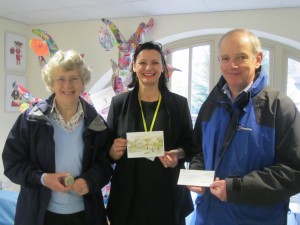David Bettiss and Tricia Hall presenting a cheque for £600 to Caroline Roberts-Quigley Head of Fund Raising at Chestnut Tree House Children’s Hospice. This money was raised from the sale of Christmas cards, calendars and painted pebbles designed and painted by Tricia.
Monthly Archives: February 2016
Group Meeting – 26th February 2016
Our meeting opened with Ed Miller informing us that David Bettiss and Tricia Hall presented a cheque for £600 to Caroline Roberts-Quigley, head of fund-raising at Chestnut Tree House Children’s Hospice. This money was raised from the sale of Christmas cards, calendars and painted pebbles designed and painted by Tricia. Ed went on to say that the Community Orchard trees were doing well at the Glebelands recreation ground and that a tree planting session was planned on Tuesday 15th March for the banks of the river Rife for a 10am start, meeting at the footbridge. The Woodland Trust have donated 100 small trees for this project. Also our annual Rife Clean is planned for Saturday 19th March, meeting at 11am at the Bluebird Café car park. Refreshments at the Country Centre will follow both events. Ed asked if members could e-mail any articles or photographs they may have for our annual magazine to Tricia Hall by the end of February.
To follow, Tricia Hall advised us that a red kite and 7 buzzards had been spotted over Ferring and then showed us a buoy with goose barnacles attached to it that was found at the Winter Beach Clean on 7th February. These barnacles start life like small shrimps and are filter-feeding crustaceans that live attached to hard surfaces but can occasionally be found on debris that has been dislodged from the seabed and washed up on the shore.
Ed Miller commenced his planning update with the news that the Arun Local Plan is to be redrafted to meet the Planning Inspector’s requirement of 845 homes per year for the next 15 years. It will be autumn before the draft plan is ready and it is unlikely to be adopted before 2017. The Peugeot car compound application has been granted on appeal and 3 further applications have now been submitted for the same site. Also an application for 23 yurts plus ancillary buildings off McIntyre’s Lane has been submitted by Hatch Homes Ltd.
After tea Matthew Thomas an ecologist gave an interesting, illustrated talk regarding the Steyning Downland Scheme (SDS). This scheme was started when it was realised by the current owners of the Wiston Estate that much of the 160 acres of chalk grassland was not being managed. A well-attended public meeting was held in 2007 with the aim of bringing together the needs of the people and wildlife. A steering group was formed of local people where aims and objectives for the scheme were developed. An area has been designated for mountain bikers; a team of local people can survey the plant life; a website has been created; children enjoy educational days on site, and the addition of suitable fencing has allowed cattle to graze there once again. This scheme has achieved charitable status since 2009 and the Wiston Estate continues to invest in many different ways. There are over 120 volunteers involved and the scheme has blossomed into a much bigger reality than was first conceived. It has also been discovered that this area is one of the top sites for the rare Brown Hairstreak butterfly. Also the rapidly declining and threatened Duke of Burgundy butterfly has been handed a lifeline with the help of the SDS, the Southdown National Park and the Royal Botanic Gardens, Kew. Over the next 2 years, with the help of Neil Hulme, a butterfly expert, and local conservation volunteers, work to encourage the Duke of Burgundy back to the chalk grasslands of Steyning by creating the right habitat and by planting cowslips, which are their main food source, will get underway.
Community Orchard Planting Project 11th February 2016
On a beautiful sunny, but cold February morning 30 volunteers met at the Glebelands Recreation Ground in Ferring with spades at the ready to plant our first Community Orchard. The orchard consists of 19 trees including 13 apple trees (all Sussex heritage varieties such as Tinsley Quince, Egremont and Alfriston), plus 2 pears, 2 plums and 2 cherry trees. On hand to give expert advice was John Coote from the Brighton Permaculture Trust. John generously gave his time and expertise to ensure the correct planting of the trees by some novice volunteers.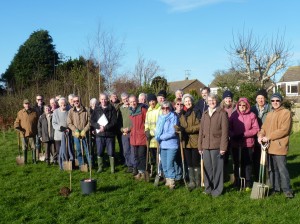
This orchard was supported by Ferring Parish Council in the form of a grant they awarded to the project. In addition Arun District Council gave their permission as the landowner. Thanks also go to Community Parks Officer, Martyn Burkinshaw; Malcolm Linfield, the manager of Ferring Country Centre, along with Jamie and Andrew from the Centre who joined 26 members of Ferring Conservation 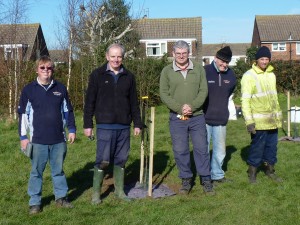 Group in the planting of the trees.
Group in the planting of the trees.
David Bettiss, Chairman of Ferring Conservation group said “The Ferring Community Orchard is a great example of the local community coming together to provide an excellent addition to the village scene. It will improve the biodiversity in the area. It will provide fruit in years to come and will be an area of interest for local people and visitors. I am very grateful to our individual members who have paid for the trees, in many cases as tributes to loved ones no longer here, and all the partners we have worked with closely to make the project a reality. I am very pleased to finally see all the trees planted and hopefully the orchard develop into the future”.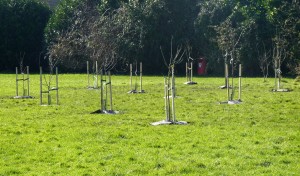
Community Orchards are a government initiative that helps communities to make the most of their local green spaces. Orchards were once widespread throughout the British Isles and until recent times every farm, country house and suburban garden had its own fruit trees. Pressure on land for new houses and roads and the importation of cheap fruit from abroad has caused the loss of many of these small orchards. The acreage of commercial orchards has declined rapidly too. Community Orchards help to revive an interest in fruit growing and provide a way of sharing knowledge and horticultural skills and stimulate us into growing food for ourselves again.
Jane Hayman
Winter Beach Clean 7th February 2016
24 members met by the beach huts for an extra beach clean following stormy weather with high tides. A lot of wood had been deposited on the beach togather with plastic buoys and old lobster pots. It was extremely windy making it difficult to pick up tiny bits of paper and plastic so we concentrated on the larger objects. Sue and Tony Palmer did sterling service dragging the trolley which was piled high with rubbish.
Several of the plastic buoys were covered in Goose Barnacles, strange relatives of the 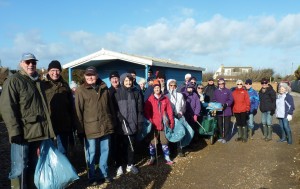 prawn and crab family, the Crustacea. They start life as little shrimp-like creatures which then attach themselves to floating objects like wood, plastic or the bottoms of boats. Here they develop into stationary filter-feeders with white shiny plates covering their bodies which hang from a stalk. We even found a plastic water bottle with Goose Barnacles growing out of it, looking like a strange bunch of flowers! In fact the bottle would have been floating upsidedown with the Barnacles hanging underneath.
prawn and crab family, the Crustacea. They start life as little shrimp-like creatures which then attach themselves to floating objects like wood, plastic or the bottoms of boats. Here they develop into stationary filter-feeders with white shiny plates covering their bodies which hang from a stalk. We even found a plastic water bottle with Goose Barnacles growing out of it, looking like a strange bunch of flowers! In fact the bottle would have been floating upsidedown with the Barnacles hanging underneath.
Several members also took part in an improptu ‘treasure hunt’ to find 12 objects of animal or vegetable origin which had been stranded on the beach.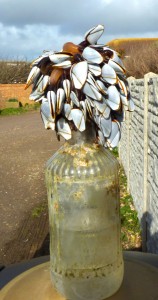
Tricia Hall, on behalf of the committee, thanked Jenny Grixti and Sue Palmer for organising the event and she thanked so many members for turning out on such a wild and windy day. Four more beach cleans are planned for the summer.
Tricia Hall
Bird Walk on 2nd February 2016
At 0945 on Tuesday morning it was grey, damp and chilly and it didn’t
bode well for our planned walk to Michelgrove lane but by the time the
seven of us had assembled under the trees near Michelgrove House and set
off, the skies gradually cleared so by 1100 it was near cloudless and
very pleasant.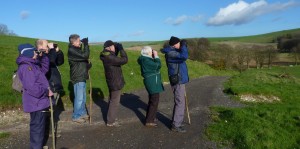
We soon saw one of our target birds, a Red Kite, wheeling over the
countryside to the east and it was later joined by a second.
Continuing up the Lane into the Angmering Park Estate we crossed a stile
on to springy downland grass with the sound of Skylarks above us and
soon after the croaking call of Ravens. A pair were having a tussle with
two Buzzards. Up to five of the latter were later in the air together
over Blackpatch Hill.
In or near the leftovers of a maize crop, about 15 Yellowhammers, 30
Chaffinches, two Meadow Pipits, eight Red-legged Partridges and several
Pheasants all showed well in the bright light. Nearby, a Corn Bunting
sat singing on a fence only a few yards from us.
We descended through a wood on the eastern slope of Harrow Hill in warm
sunshine along a steep and rather sticky path emerging in a valley with
a horse training gallop in the bottom (unoccupied). Another distant Kite
was over the South Downs Way.
Gulls and Rooks were abundant on the last leg across the field back to
the road and a Great Spotted Woodpecker was seen when we returned to the
cars.
In all, some 26 species of birds were noted – better than expected when
we had set forth from Ferring!
Clive Hope

